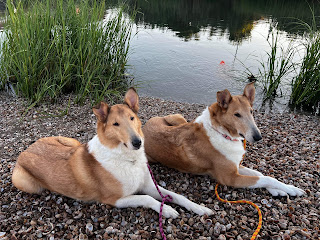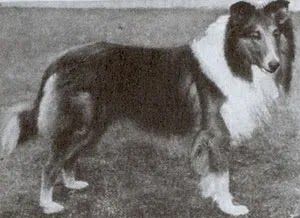Volunteering with your dog can be very rewarding. One way to do this is to get your dog certified as a therapy dog. It requires a monthly commitment, but some therapy dog teams (meaning owner and dog) do weekly visits. There are many ways to provide pet therapy, you can visit Nursing homes, hospitals, airports and even court rooms. Therapy dogs are even participating in a program called READ, where young children struggling with their reading skills will read stories to a therapy dog.
To get your dog certified as a therapy dog, you must first choose which therapy dog organization you want to join. Why is this important? Each organization has their own set of rules you must adhere to, in order to be a member and be covered by their insurance. Each organization also has their own test, which your dog must pass in order to become certified as a therapy dog.
I have had three of my own collies pass the test, and some of the collies from my past litters are also working with their families to provide this valuable service. With collies being such an intuitive breed, I have found that they easily pass the test with very little training needed. To me, the biggest requirement in becoming a therapy dog is a solid temperament. Without that, the dog may not be comfortable around sick individuals or people who are upset or crying. The dogs may also not be comfortable with strangers reaching out to pet them, or with having strangers seeking comfort. Some dogs that normally have very even temperaments may still not be comfortable in these types of situations, and that is okay, not every dog wants to be a therapy dog.
For those dogs that do enjoy it, the testing to become certified usually includes the following:
1) Initial meeting
The dog is seated at the handler's left side. The evaluator approaches the dog and the handler and stands facing the team from a distance of about 4 feet.
The evaluator approaches and enthusiastically greets and touches (handshake, pat on the arm, etc.) the handler.
The evaluator asks the dog's name, loudly repeats the dog's name, and then circles the dog and handler.
The evaluator inspects the dog, petting the dog and touches ears, mouth, paws and tail.
The evaluator may hug the dog.
Note: This portion of the test is the ideal time for the evaluator to examine the dog for cleanliness, grooming, health, parasites and proper weight. The evaluator should nicely and diplomatically point out potential health problems, excessive weight, and other issues and make helpful suggestions.
2) Cane/awkward stranger
The dog is seated at the handler's side, the evaluator approaches with the cane moving erratically with hunched posture, while speaking in an odd voice. The evaluator pats the dog on the head and body and bumps the dog gently with the cane.
3) Quiet Crowd
Groups of people (2-5) stand in a gathering. If possible dogs (1-2) are present with the group of people. Medical equipment (wheelchair, walker, cane and crutches) is present during the test.
The dog and handler walk together with a loose lead threading though the group of people.
The dog may be on either side of the handler.
Groups of people mill around and quietly talk to one another.
Creating their own heeling pattern, the dog and handler make right, about & left turns while meandering through the crowd.
The dog and handler wander casually through the crowd three times.
4) Training
The handler positions the dog to the left and faces the evaluator.
This test is performed with the use of a 20' long line.
The handler replaces the leash with the long line and drops the long line to the ground. (The evaluator may step on the leash to keep the dog in place during the stay.)
Also part of the training portion of the test:
Sit: The evaluator asks the handler to sit their dog. The handler may give more than one command and coax the dog into potion. The handler must not force the dog down into a sit with their hand.
Down: The evaluator asks the handler to down their dog. The handler gives the dog the command to down. The handler may use more than one command. The handler must not force the dog into position with their hand.
Stay: The evaluator asks the handler to tell the dog to stay (from either a sit or a down – handler preference). The handler gives the dog the command to stay, walks to the end of the long line and returns to the dog. The dog should remain in place while the handler returns to the dog at a normal pace. The handler may tell the dog to stay more than once and if necessary, back away from the dog telling the dog to stay repeatedly. The handler may take a fair period of time, give the dog more than one command to stay and reposition the dog a few times, if they break the stay.
Come: The evaluator asks the handler to tell the dog to stay (from either a sit or a down – handler preference), to walk out to the end of the long line and call their dog. The handler gives the dog the command to stay, walks to the end of the long line, turns and calls the dog to come to them. The handler may use more than one command.
5) Food distraction
The dog is seated next to the handler facing the evaluator. The evaluator drops a piece of food on the floor. If possible dogs (1-2) are present with the group of people.
The evaluator instructs the handler to walk past the food with the dog at the handler's side.
The handler and dog then turn and while walking back, pick up the piece of food.
6) Walker
While the dog is seated at the handler's side, the evaluator approaches noisily with the walker.
The evaluator pats the dog on the head and body and bumps the dog gently with the walker.
7) Loud crowd
Groups of people (2-5) stand in a gathering. If possible dogs (1-2) are present with the group of people. Medical equipment is not present during this portion of the test. The handler and dog team walk briskly through the crowd while being exposed to the following diversions:
A metal bowl is dropped behind the dog and handler.
Pans or bowls are clanged together.
People are loudly laughing, talking and slapping each other on the back.
One of the evaluators runs.
An evaluator shouts loudly at another evaluator simulating an argument.
(Other distractions may be used, depending on the circumstances of the test: opening and closing an umbrella, passing with a noisy cart, someone rides by with a bicycle, etc.)
8) Canine to canine interaction
Two handlers and their dogs approach each other from a distance of about 15 feet, stop and speak to each other, turn and line up facing the same direction and walk forward for about 10 feet.
9) Crutches
While the dog is seated at the handler’s side, the evaluator approaches with the crutches, as if disabled.
The evaluator pats the dog roughly on the head and body and bumps the dog gently with a crutch.
10) Working with other therapy dogs
An evaluator/test dog team approaches the handler and dog. The handler and dog are positioned with the dog seated at the handler’s side. The evaluator/test dog positions themselves the same way, but facing the handler and dog situated about 5 feet apart. The two teams hold this position for 10 seconds.
The handler/dog team holds their position and the evaluator/test dog team swing around so they line up alongside the team being tested. The teams hold this position for 10 seconds.
11) Wheelchair
The handler and dog approaches the wheelchair from a distance of about 5 feet. The handler leads the dog up to the wheelchair and encourages the dog to interact with the evaluator. The evaluator gently pats the dog and bumps the dog with the wheelchair.
They are testing the dog with as many scenarios as they can, so they can predict or determine if the dog will remain calm and unfazed with many types of individuals and in many different locations. It is very heartwarming to see people’s reactions to an approaching therapy dog, and I have really enjoyed the experience. You can tell by the joy on their faces that your dog has brightened their day. You can read about my first Therapy dog, Ryder, by clicking Here. Ryder is still doing visits for now, but his 12th birthday is fast approaching and he can’t do as many visits as he did in the past. I’ve been working with Addison, to see if she would enjoy becoming our next Therapy dog. I’ll hopefully have an update next week, we will see How it goes!


















































